We asked the tango community worldwide what tools, policies or other ideas they thought should be considered when tango reopened. There was a great diversity of perspective, including some conflicting views. At the time (early summer of 2020,) most believed practical measures would be sufficient. It is useful to consider the time frame of the survey when engaging with these answers.
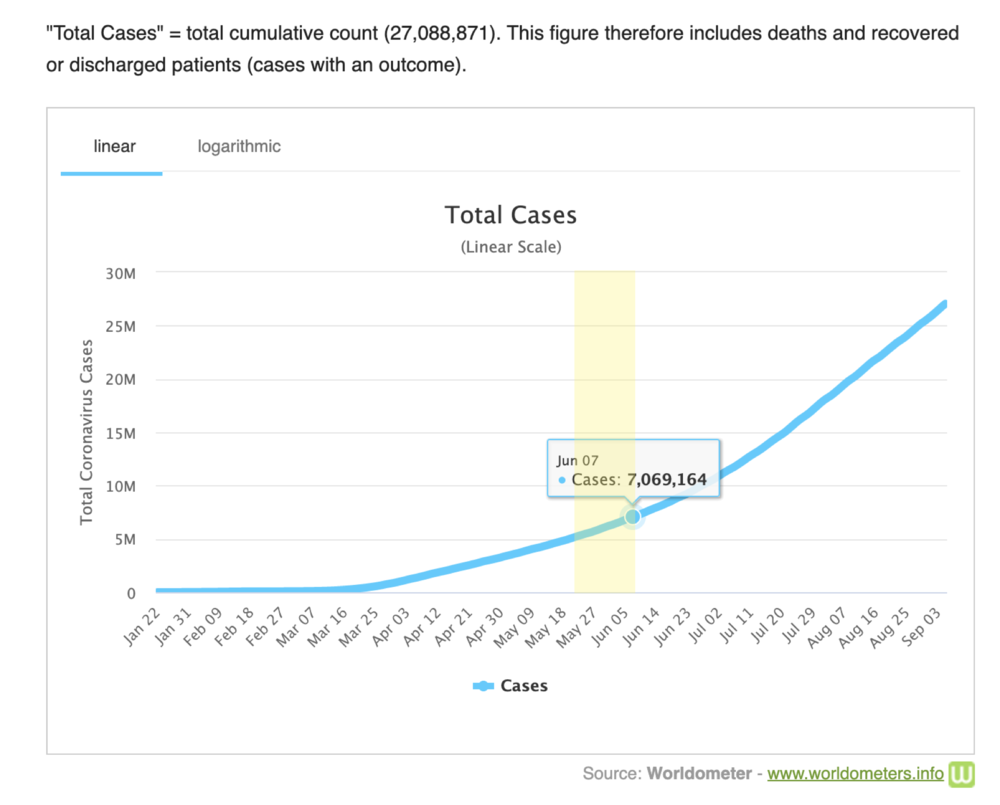
The Survey was open between May 21 and June 7, 2020. In the US, many states were in the early phases of re-opening and already reports of new case surges was fuelling discussion around public health policy. In Europe, the re-opening process was underway in April, but generally with stricter guidelines, while in Argentina the lockdown in Buenos Aires was beginning a long string of extensions. Answers to this question reflect the uncertainties and debates that accompanied the beginning of this re-opening process and clearly the intervening months shed some light on the discussion.
The survey responses were coded into categories, as shown here.
-
Vaccine 83
-
Waiting 37
-
Don’t know 85
-
Consensus 36
-
Negative 25
-
Open Embrace 21
-
Goals 14
-
Local 14
-
Fear Factor 10
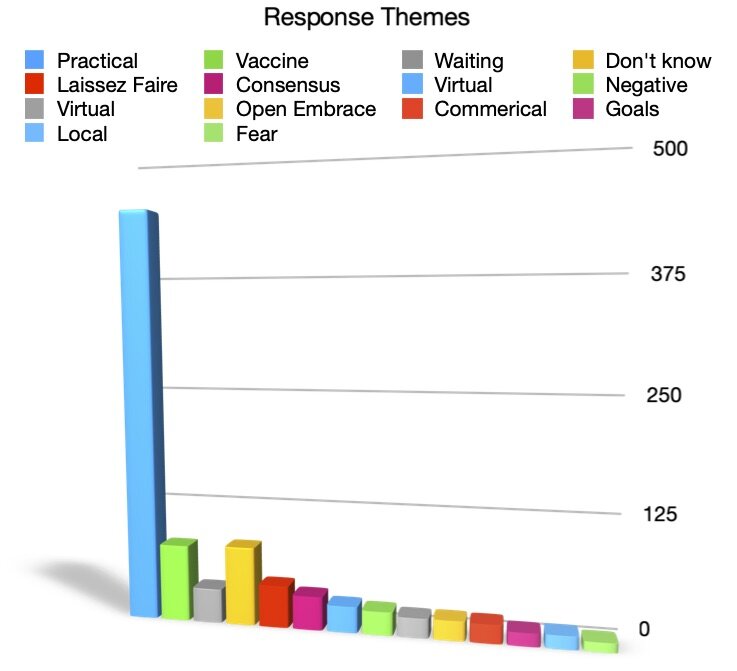
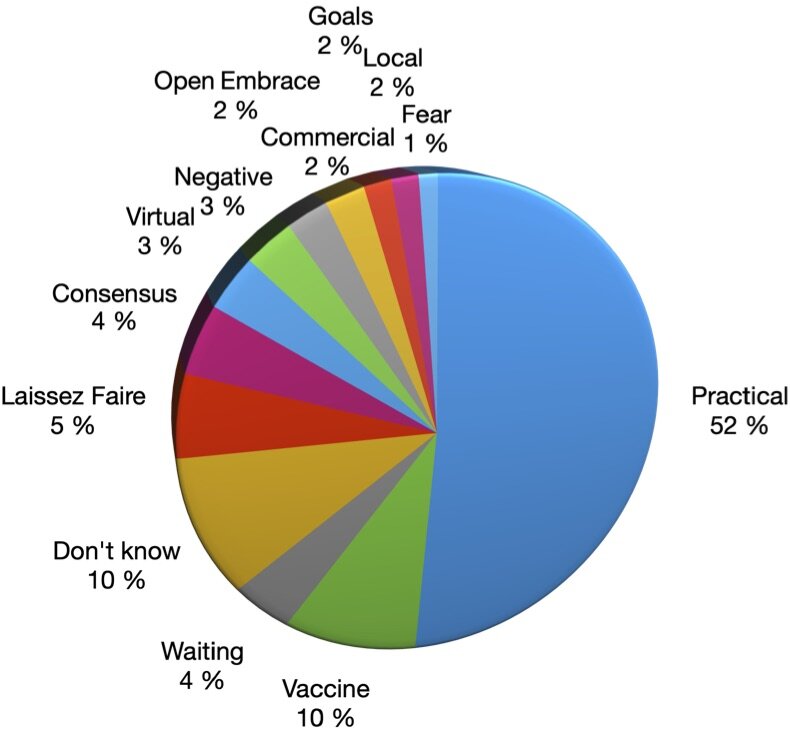
Practical Measures
Over half the responses to this question addressed practical measures, health guidelines and concrete policies to be considered as part of returning to tango. Hand washing / disinfecting, self-quarantining, and masks were the most often mentioned. Other precautions include entrance screening (for symptoms or health certification), larger venues, smaller numbers of dancers, contact tracking, restricted partner changes, ventilation, limitations on food and drink in the milonga, and signage explaining policies. Many responses cited current and past failings in self quarantining and expressed concerns about non-compliance with policies.
“As a medical professional I fear that people will return to tango as quickly as possible, even if they are sick or have been exposed to many people, causing another CoVid hot spot…I know not all will comply, and for that reason it is unlikely I will participate prior to a vaccine being available.”
This skepticism of compliance connects to a general lack of trust in the tango community’s hygiene in general. Many reported getting sick from other dancers in the past.
“This is too overwhelming for me to consider. I routinely get sick in BsAs at least every stay (I live there part time and go 3 times per year for a total of 5 months). It has always been a difficulty for me… “
Some mentioned the potential for small home milongas, and even the possibility of virtually connected home milongas. Themes mentioned less frequently included contactless payment, pre-registration with lenient cancellation terms, and time lags between event visits. The general aim of these comments is well summarised in the following reply:
“Things that make people feel safe to return to dancing”
Not only was this the largest group of responders, the make up of the group is very representative of the survey population as a whole.
Vaccine
Responders in this group voiced a similar perspective to the group above, but specifically cited the availability of a vaccine as a pre-condition for a return to tango.
“Tango won’t be able to reopen as we know it until there is a vaccine”
“Well I know for myself I will start dancing tango once the vaccine is available. I am over 60 years old and I have grandchildren I would not want to expose unnecessarily.”
“I don’t see how anything other than a vaccine can make tango “safe.””
Some responses echoed a sentiment from the category above, not trusting the tango population to self quarantine:
“I’d only dance if I had a vaccine. I wouldn’t trust that other people would stay home if they felt unwell. They never have before.”
“I assume that most of us will be protected by vaccines/antibodies by the time I participate in live tango events again. But, more than ever before, this crisis emphasizes the importance of NOT attending such events if a person is sick.”
Several responses acknowledge the further challenge of getting people to take an available vaccine.
“Tell everyone who goes to tango to be vaccinated.”
“People should show proof of vaccination.”
As a group the vaccine themed responders are generally similar to the full survey population. However amongst tango professionals, the group expressing the importance of vaccines is less reliant on tango for income. The group is more concentrated in North American and age of this group is also older then the general survey population.
Vaccine Group General Survey Population
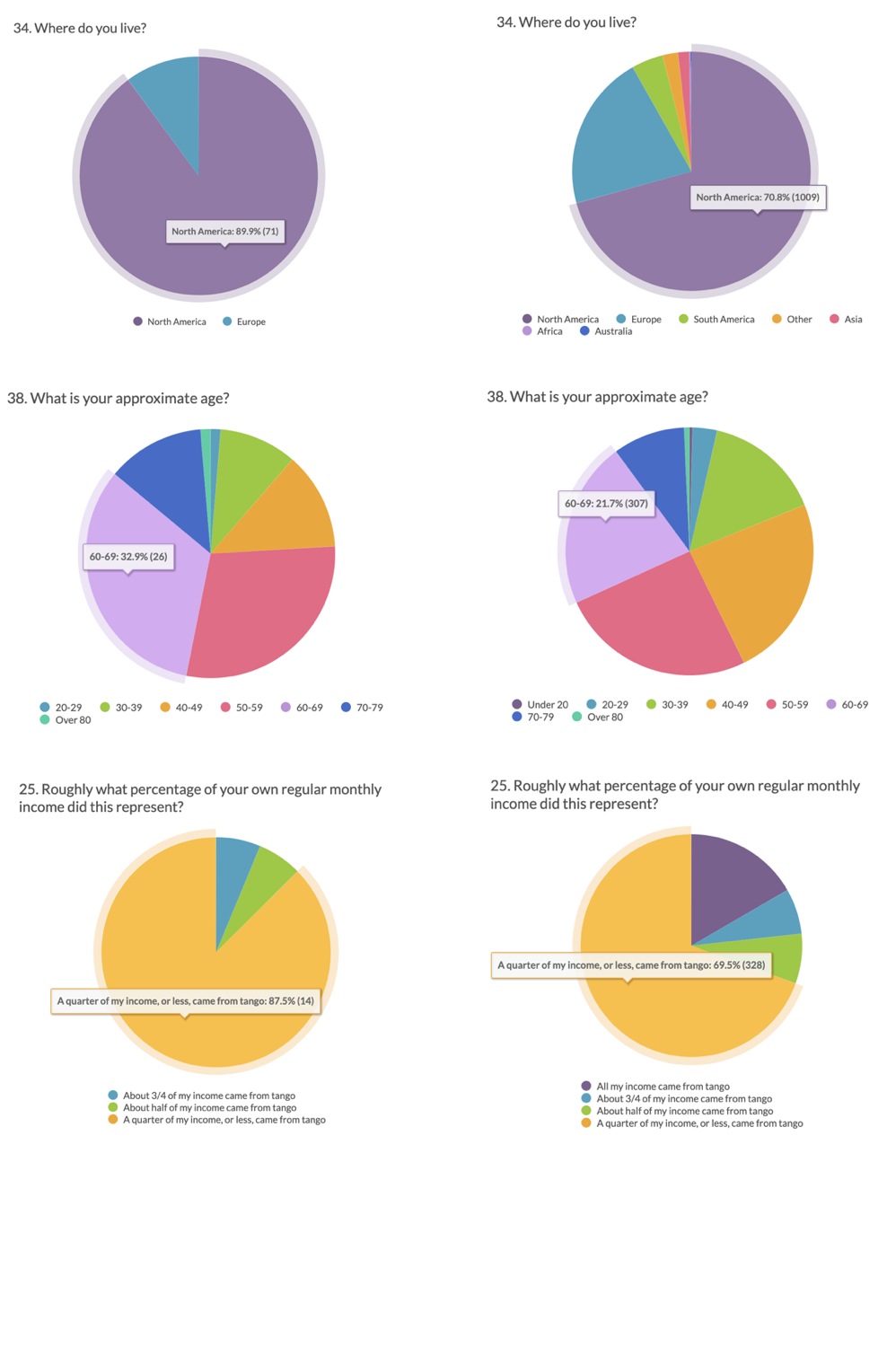
Waiting…
Closely connected to the vaccination responses was a smaller group of responses that expressed the desire to wait generally.
“…Waiting until we know more, have more options, etc. is but a small price to pay for a successful reopening of tango.”
“This is a very complicated question, which will depend A LOT on how the virus is evolving – vaccine, medicine. I think, it’s a bit early to say.”
“I think we still need more information before we can answer this question.”
“Patience.”
Given that the survey was active in the first months of COVID lockdown it would be interesting to see how the same responders perspectives have changed. But these responses reveal a feeling among some in the moment of the survey that it’s just too early even begin the discussion.
Don’t Know
A variant of the “waiting” responses were those who simply found no basis for voicing an opinion on the topic.
“I have no idea.”
“Unsure.”
“I’m clueless.”
“?” [this answer actually appears many times]
The particular content of these responses is perhaps not so revealing, but that this group accounts for 10% of all responses (the 4th largest group from the 13 coded response groups) seems noteworthy.
Laissez-faire
About 5% of respondents express a very different perspective on the topic of necessary policies or ideas to consider, namely let things be as they’ve always been. Many responses consist of only a few words: “none,” “nil,” “no new rules.” There is a prevailing sentiment that new guidelines would restrict freedom and diminish the tango experience.
“No rules or policies. People need to feel free.”
“I don’t think there should be some policies in tango. It would destroy the nature of the dance.”
Part of this perspective often seems to be placing the responsibility on individuals instead of organizers or collective decisions:
“None. It’s up to individuals to protect themselves and act responsibly, same as before – wash hands often, stay home when sick, etc.”
“Wouldn’t change anything. Dancers need to understand the risk.”
“Tell people that there is no social distancing in tango, that there is inherent risk”
Some answers take a more aggressive tone expressing an opposition to the framing of the situation, particularly around the role of fear (see below) in the process of adapting to current conditions.
“TANGO SHOULD BE USED AS MOTIVATION TOOL AGAINST FEAR OF CONNECTION – IT SHOULD NEVER STOP”
“Here’s an idea: stop believing everything you’re told by ‘authorities’”
Hear is how one responder expresses the sense of Laissez-faire:
“Whoever is willing to come back does and whoever is scared stays away. Tango should not become a confrontational place in which « masks » or « social distancing » terrorists starts spoiling our fun. People have been [dancing] tango for decades through diseases, pandemie’ and crisis and has not changed since. It should remains as is.”
Such perspectives show a great potential for conflict with groups who feel the safety of the group is a collective responsibility and requires collective agreements and policies. This struggle between individual autonomy and group security can be considered a defining characteristic of any group, and it’s a theme we would do well to consider both for ourselves and our community.
Demographically, this group is slightly more male (43% vs. 34%), and slightly fewer years in tango relative to the survey population. The percentage of respondents from Canada (25% vs. 13.8%) and UK (4.5% vs. 2.2%) is nearly double that in the full group.
Laissez Faire group General Survey population
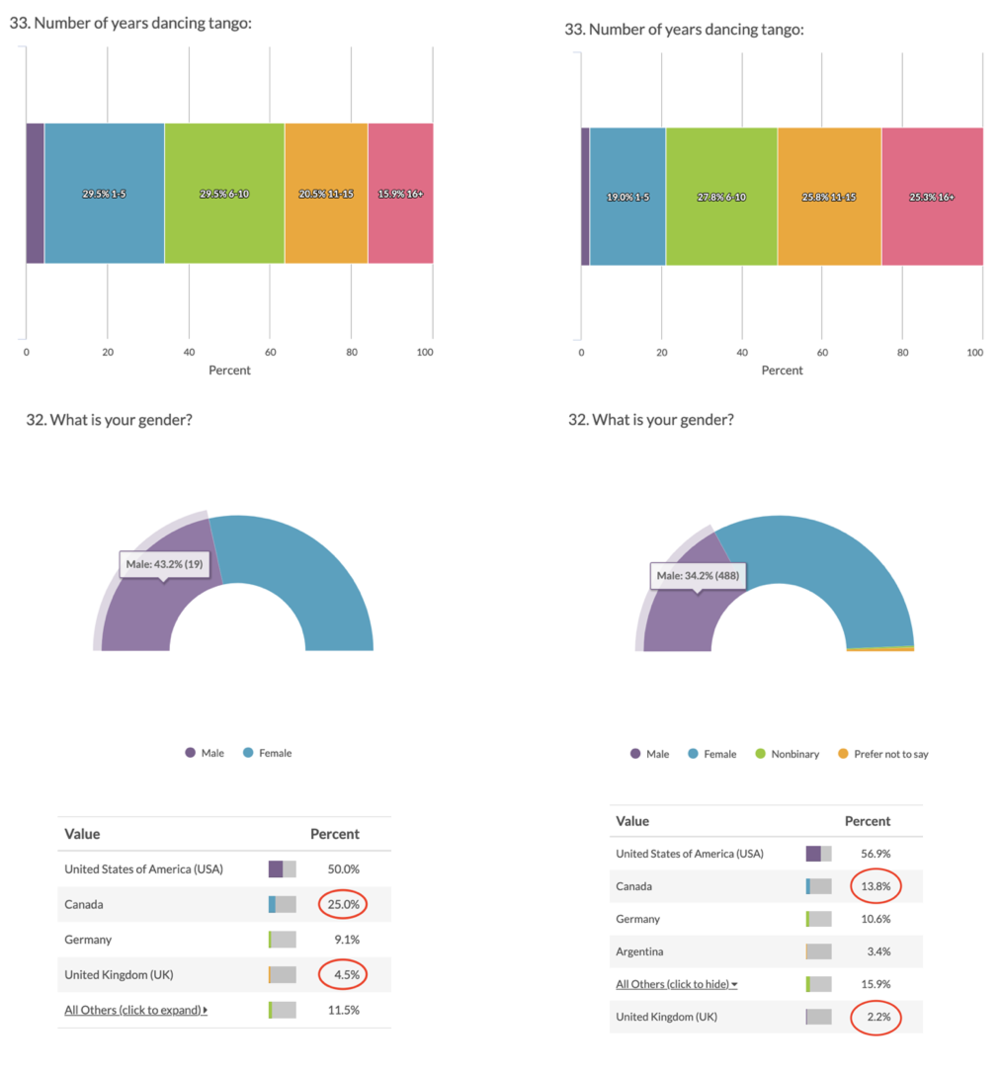
Consensus
A similar number of responders presented a counter perspective to the views voiced above. This group expressed the wish for some consensus building, community-wide conversation, and a collective commitment to shared principles and policies. The following response shows both the overlap (personal responsibility) and clear contrast (collective or authoritative expectations) between groups:
“Make sure that every dancer is aware of his/her responsibility of protecting one another… Milonga organizers should have every tanguero,(era) read and sign such rule at admission before accessing the dance floor… “
Where the Laissez Faire group proposes each dancer is responsible for themselves, the Consensus group proposes each is responsible for the group. Generally responses from this group are longer :-), acknowledging the challenges in building agreement.
“Public Health hygiene must be well understood and followed. Compliance is a big problem. Having accurate shared knowledge of what is safe behavior is another problem (esp. in the US, OMFG). And getting consensus acceptance of that knowledge among dancers and musicians is a problem.”
“The topic of what COVID is and how it affects people has proven to be quite incendiary on social media. When we open up, there will be people arguing about things like mask vs. no mask. These arguments need to be addressed before we open events in some way. Maybe a unified (if possible) declaration by tango organizers in support of whatever is decided – for example if it is decided that not everyone needs to wear masks, there needs to be enforcement of non-bullying towards people who choose to wear masks… There are more things along these lines that we need to think about and work on, and … we need to have as unified a policy as possible (I think)”
There are also frequent expressions in this group of a need for tolerance of different views.
“tolerance for people making different choices”
“Being kind despite differences in opinion or belief. Literally, just be an adult.”
Compared to the general survey demographic, this group has considerably more years tango experience (75% more than 11 years, vs. 51%). There is also a higher percentage of responders from the USA in this group 72% vs. 56%. This perspective also skews toward larger communities, and has a higher percentage of responders under 50 years of age than the full group.
Consensus group All Responders
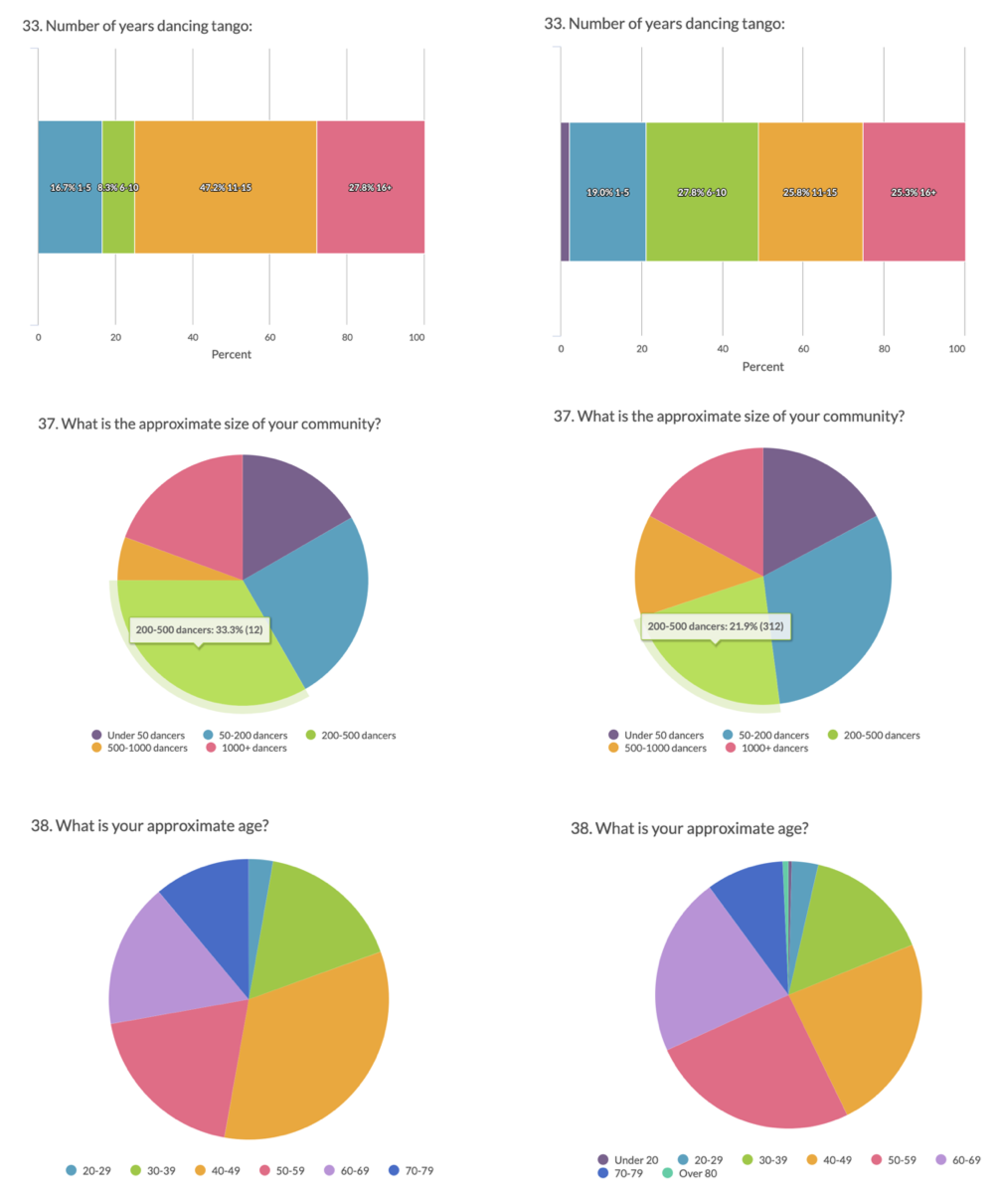
Virtual Tango
3% of responses mentioned the wish to retain virtual or on-line tango offerings as part of the return to tango.
“continue to offer classes online. I think it’s great to now have access to teachers from all over the world without having to travel.”
“Keeping some online classes available, especially lectures and solo technique classes”
“Continue online classes for people who do not want to join as they have members in the family that are at risk.”
Some suggest hybrid learning events with virtual specialists and local support.
“Guest teachers by zoom with local teachers correcting mistakes This is better than 100% zoom classes and gives a chance to take lessons from out of town teachers”
Another novel suggestion involved virtually connected smaller events into a larger networked milonga.
“One alternative I can think of is to have a bunch of very small speakeasy milongas in homes connected virtually.”
This group of responses has a higher percentage of women, and more dancers from the 40-49 year old age group, and a notably higher level of education compared to survey population.
Virtual group General Survey population
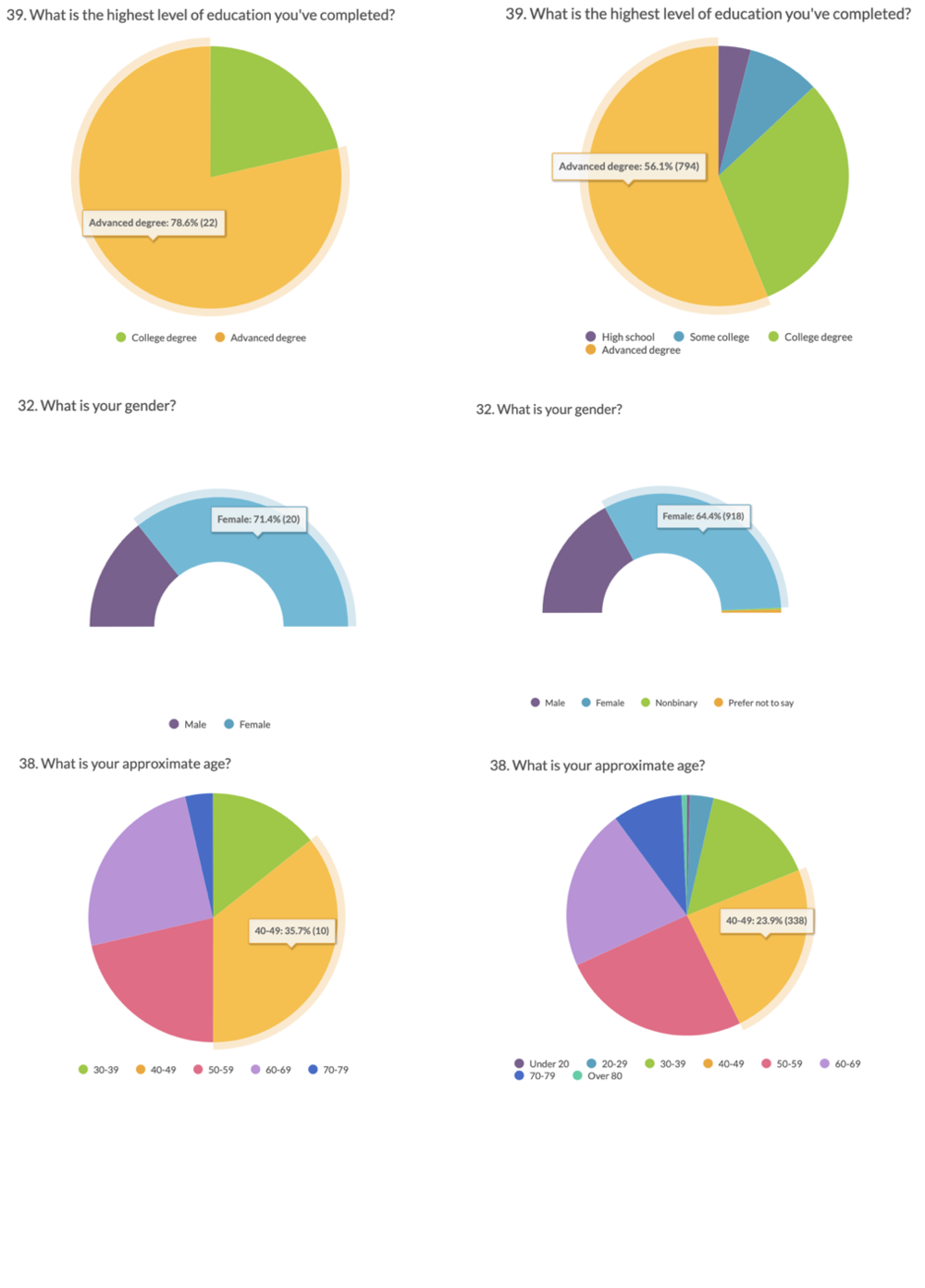
Commercial Concerns
20 responses focussed on issues related to the tango marketplace and concerns of tango producers. Pre-payment or subscription plans, public and private subsidies, collective pricing, collective actions for creating market visibility, are among some of the ideas often proposed to support the return to tango.
“Crear una agremiacion sería, responsable y eficaz, con miras a establecer una mejor proyección y visualización de nuestra labor.” [Creating a union would be, responsible and effective, with a view to establishing a better projection and visualization of our work.]
“Raise entrance fee one euro/dollar and have a portion go to safety net for professionals. Participating milongas will have seal of approval from governing body.”
Some argue for lower cost or free events to support dancers who have suffered economically from the pandemic, and equal number of responses proposed eliminating free or underpriced events which they saw as creating a dampening effect on the tango economy. In general, the answers in this category reveal a concern for the financial health and sustainability of tango in coming years.
Not surprisingly, this group has a higher percentage of tango workers than the general population, and amongst those making money from tango this group has much higher percent of dancers earning in the top income categories.
Commercial Ecosystem General Survey Population
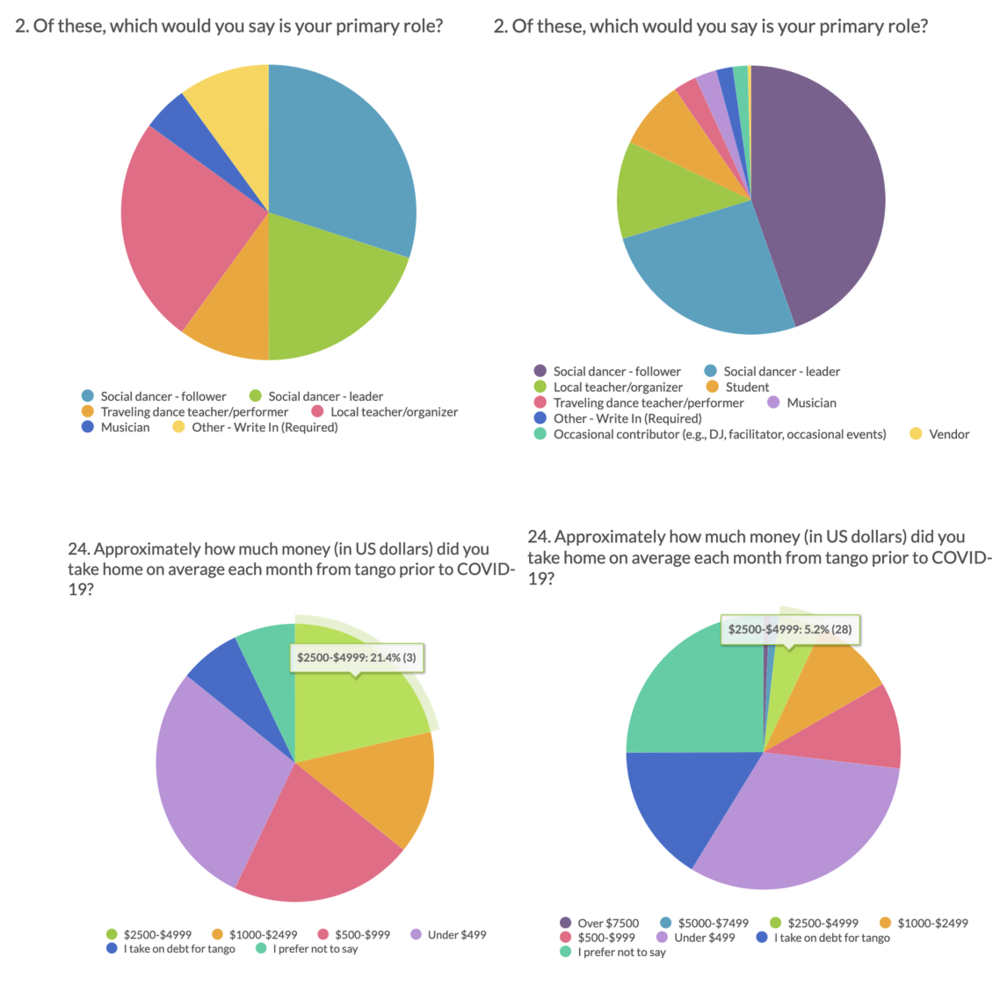
Other themes
Several other themes appeared repeatedly in the responses to this question.
Embrace
Most prominent among these were comments with the central theme of open or close embrace. Generally these responses were skeptical about the viability of dancing close embrace in the coming months or years. Some mourned the loss of their preferred connection and questioned the worth of a tango without close embrace, others celebrated what they perceived as an endorsement of the option of dancing open.
Goals
This group depicted the challenge of the current situation as a chance to improve the experience of tango – related to their particular social, emotional or aesthetic goals. The content of these answers is quite consistent with responses to the question of what people would like to see more of when we return to tango in the Idealism category. Strengthening social coherence, reducing elitism, gratitude, tolerance, inclusivity and less competition were often expressed themes.
Local
These answers posited an increased role of local tango options to offset difficulties with traveling and larger gatherings. Environmental, social, and public health arguments were articulated to support this theme.
Fear Factor
“Become fearless”
Responses in this category emphasized the importance of creating a perception of safety and countering the general feeling of fear surrounding the pandemic.
“I’m not sure how to make it safe, but that is a chief concern to relieve anxiety”
Some responders were critical of what they saw as an exaggerated or manipulative role of fear in the public dialog around COVID and tango. Others acknowledge that addressing the emotional implications of the situation may be necessary in order to create the desired feeling of security.
“Encouragement to not give in to the fear that has been communicated through propaganda “
“Educating people about our viromes, fostering better relationships w/ the viruses inside every being, for a more harmonious understanding of our biology and illnesses, that we do not fear others, but take better accountability for our health.”
Negative
The answers here express pessimism towards the future of tango and the prospects for a safe re-opening.
“If it is not safe, it will not work. If it is safe, may not be fun. I don’t know what it will take to restore normalcy.”
“As it currently stands, tango is incompatible with public health safety interventions.”
“Part of me is concerned that tango and other social dances will not be allowed to open with the rest of the economy, and even if they are, they may be taboo”
Conclusions
The perspective expressed in response to this question reveal a broad range of perspectives within the tango community. The overwhelming focus on practical measures to allow a safe return to tango arrives for us today as an almost nostalgic moment where one imagined masks and hand sanitiser would be the pathway to a speedy reopening. Particularly interesting is the acknowledgement from several different perspectives of the role that a feeling or perception of safety plays in the viability of a reopened tango. The conditions or measures necessary to support that feeling of safety may well continue to change as the situation evolves. Other themes that emerge include the role of individual responsibility and autonomy, and the question of whether that extends to concern for the well being of the group as a whole. One step in the process of reconciling these positions may be acknowledging the individual benefit or even reliance on the social well being of the community. As we’ve seen in the analysis of dancers sheltered in place with a dance partner, the potential to dance doesn’t fully meet our tango needs, an integral part of the benefit we enjoy in tango is dancing together as a group. That shared interest from all tango stake-holders gives us a useful starting point for understanding and addressing competing needs. Because the survey group is made up of both producers and consumers we can see these themes in both the individual and collective levels. Individual freedom, balanced with the well being of the whole group is a philosophical dilemma that plays out in almost any public sphere. Tango, however, with its focus on heightened awareness of both self and other, and its dependence on a community of practitioners offers a particularly rich venue this debate.